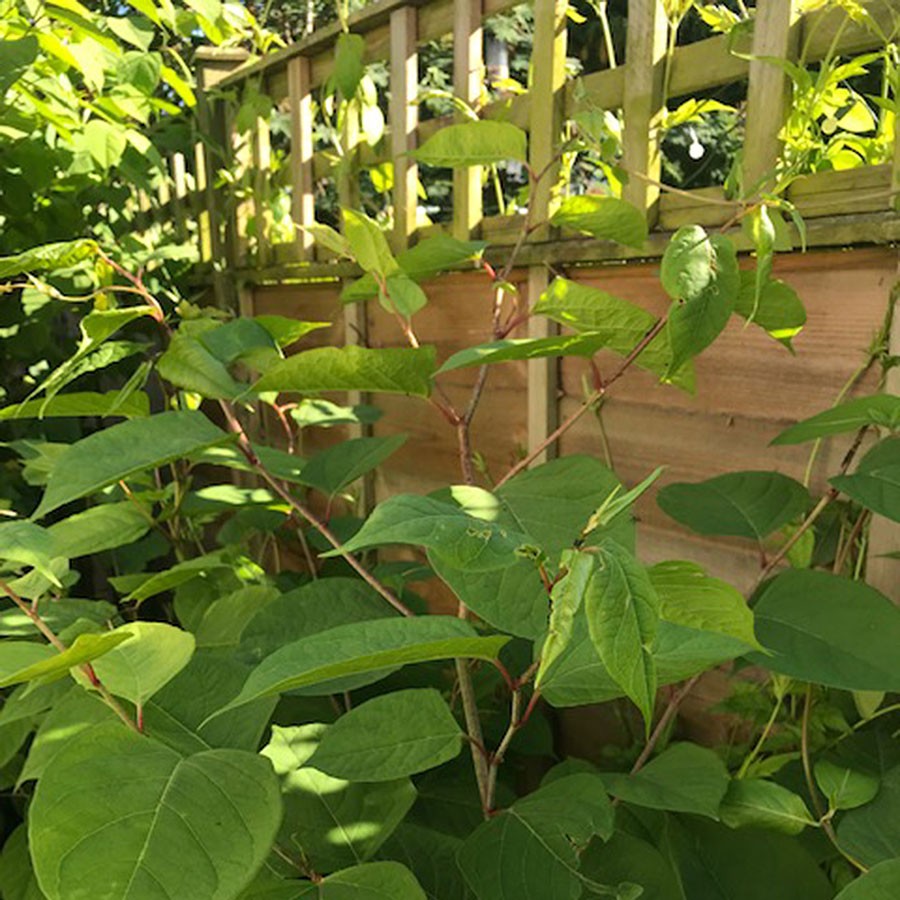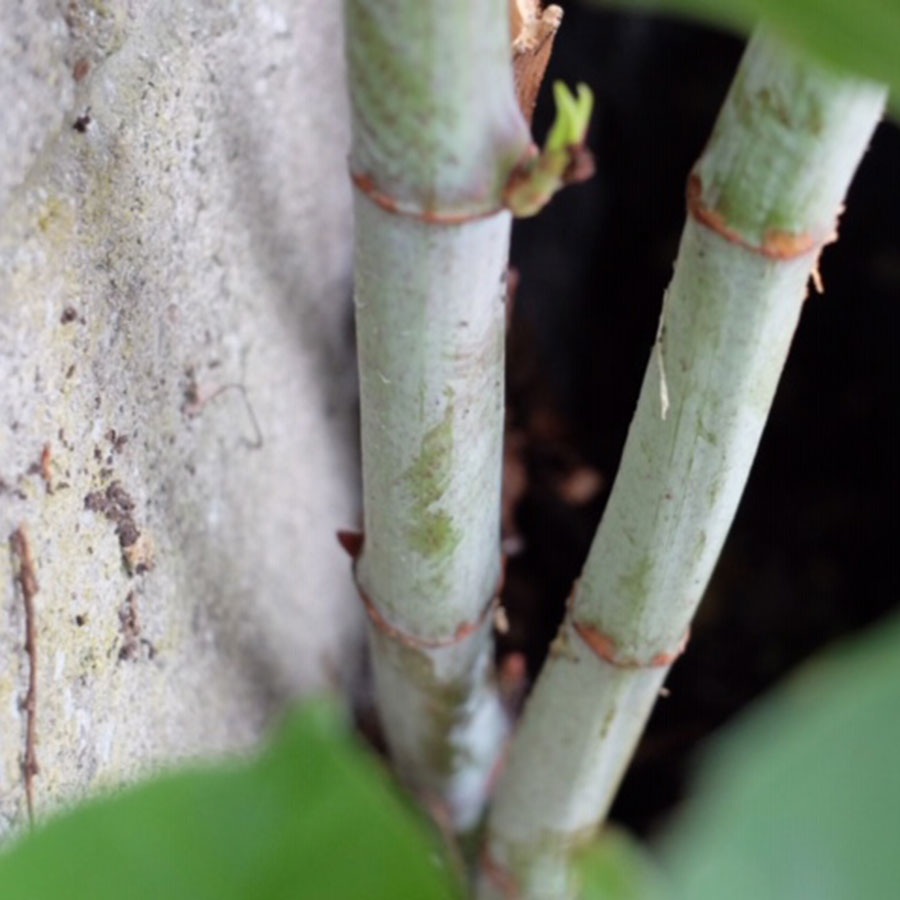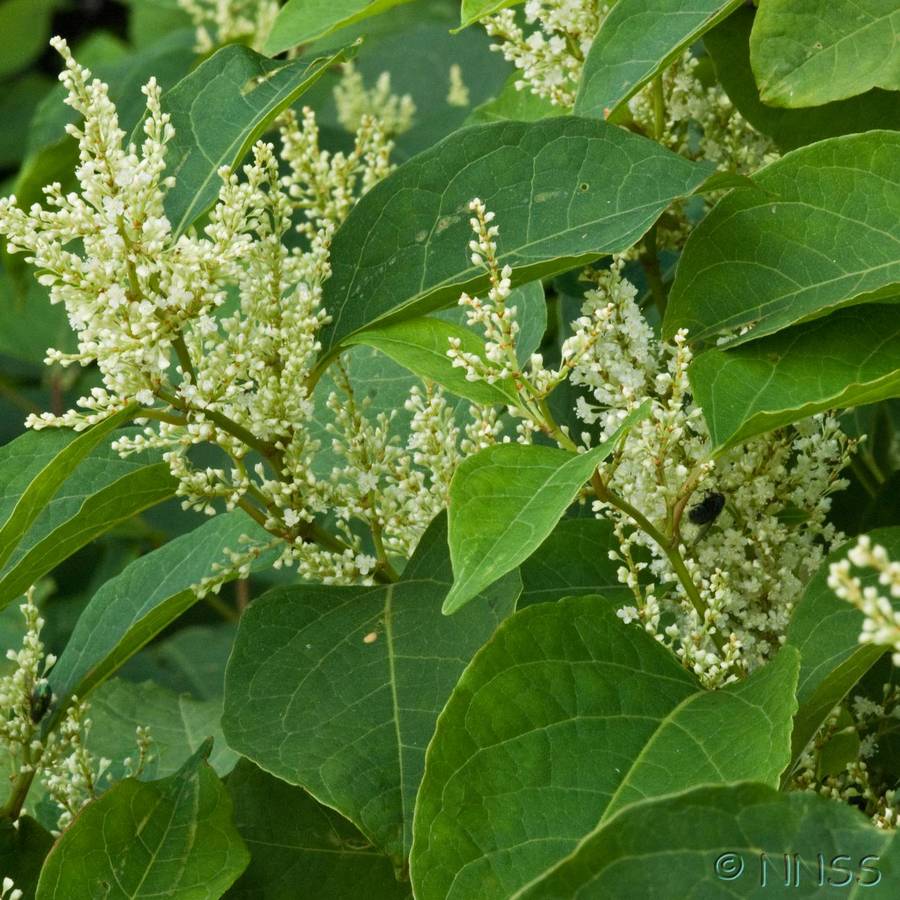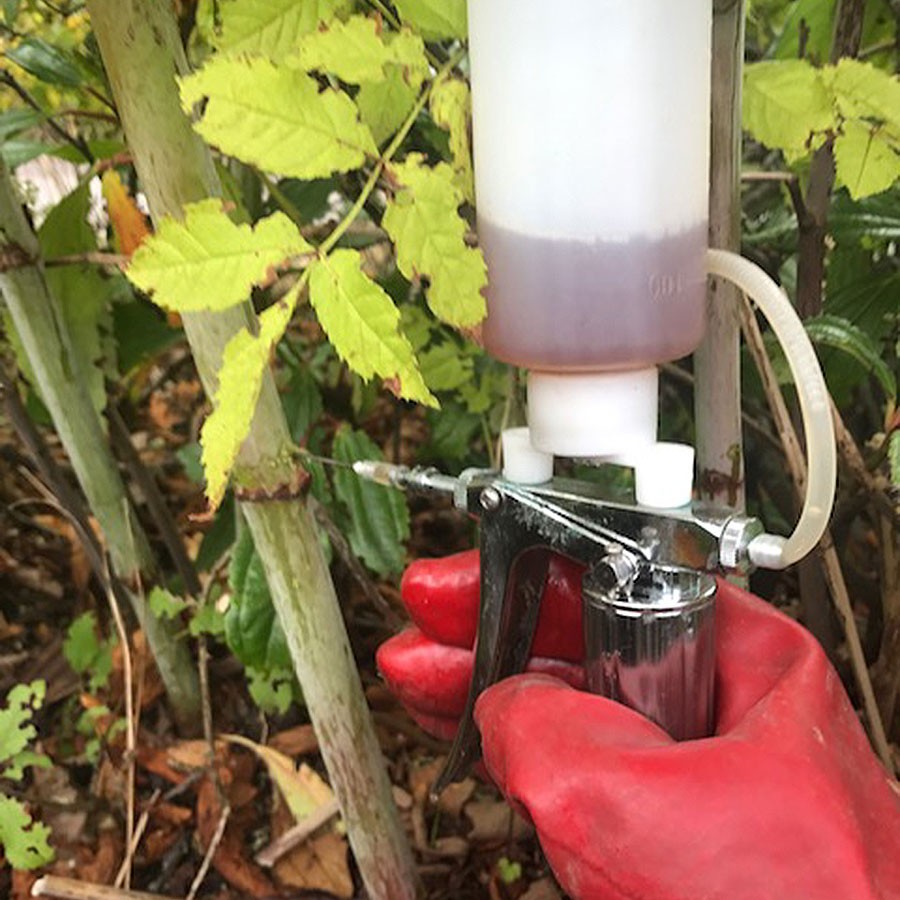Japanese Knotweed Control and Eradication in Dorset and Japanese Knotweed control and eradication locally in Christchurch, Bournemouth and Poole. Covering the whole of the county of Dorset and urban centers of Bournemouth and Poole we can provide the expertise and skill sets to deal with your invasive species problem.
We offer management plans and Insurance Backed Guarantees (IBG) to aid in mortgage applications and property sales as well standard treatment programs tailored to your budget and required duration.
Japanese knotweed natural environment is the mountainous regions of Japan and it is this once volcanic environment that shows how tough it really is.
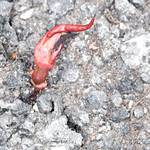 Above ground Japanese Knotweed
Above ground Japanese Knotweed
Incredibly fast growing hollow stems and large, thin leaves for optimum photosynthesis from sunlight and gas exchange, one of the primary sources of energy for all plant species. Its speed of growth and height allow it to push above other flora to ensure its intake of sunlight. In drought situations the leaves toughen to protect its water content and functions whereas many plants will simply wither. It is has in effect a ‘memory’ and stress situations such as drought or trauma will trigger a response to overcome it.
The crown
Partially above and below ground, the crown is in affect the anchor for Japanese knotweed. It is dense and heavy allowing it to take footing in the most difficult environments such as loose volcanic soil and rock, hence why it is able to easily establish in our urbanised environment of concrete, tarmac and subterranean drainage. The Crown gains mass quickly and it is this brutish behavior that contributes to costly damage to hard standings and drainage.
The rhizome
The rhizome is another serious invisible menace of Japanese Knotweed. Thin, supple and incredibly flexible. These horizontal plant stems are capable of producing root systems and shoots of a new plant, able to propagate a new independent plant without seed. In the case of Japanese Knotweed, rhizomes can extend easily 4 meters and up to 7 meters from the crown and above ground. The Rhizome of a Japanese Knotweed Plant, stores starches and proteins. This is a common process known as perennation which allows a plant to survive a poor environment for a season or two. However in the case of Japanese Knotweed this dormancy is extended and it’s possible to be as long as 20 years. Japanese Knotweed Rhizomes combine the ability to remain dormant with a biology that also enables the rhizome to extend vertically down for 2-3 meters. Again this is due to its natural habitat of volcanic regions. During a more primal time period of earth’s history, volcanos would erupt frequently wiping out flora and fauna with rivers of lava, gases and ash clouds: it becomes apparent just how resilient Japanese Knotweed is.
Japanese knotweed is classified as an invasive non-native species (INNS): http://www.nonnativespecies.org
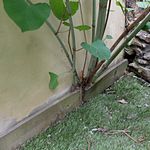 Japanese knotweed or Fallopia Japonica as it scientifically known comes under this classification for the following reasons:
Japanese knotweed or Fallopia Japonica as it scientifically known comes under this classification for the following reasons:
- Growth rate and size – outcompetes native flora
- Different reproductive cycles and methods – can reproduce without seed
- Resistant to natural predators and pests – no native insects actively control plant quantities
- Resilient to herbicides
A key term we use to look at the effect of an invasive species such as Japanese knotweed is biodiversity which means the variety of animal, marine and plant species throughout the world or a particular area. Biodiversity is key to balancing ecosystems with all species contributing in some way to creating a precise environment which humanity is essentially the main beneficiary. When bio diversity is compromised the adverse knock on effect is vast. The biggest negative effects on biodiversity are:
- Climate change
- Deforestation and habitat loss
- Overexploitation
- Invasive species
How does Japanese knotweed effect biodiversity?
In its natural environment, Japanese knotweed is not considered problematic. This is due to it being part of the correct ecosystem of the region.
- Local flora can compete with its size and growth e.g. bamboo = reduction in size and mass
- Natural control from effective insect and herbivore species = reduction in quantity
- Social awareness and biosecurity = preventing spread in urban areas
In the UK, Japanese Knotweed has acute adverse impacts to biodiversity.
The presence of Japanese knotweed effects the surrounding environment greatly by what is known as habitat modification:
- Dense tall growth obscures light to smaller native plants and shrubs which produce flowers and fruit = denies food sources and pollination = reduced insect levels = reduction of small mammals, birds and amphibians’ food sources
- Large outbreaks of Japanese Knotweed can obstruct and divert natural mammal pathways due to the density of crowns and old growth, bringing them closer to roads and other man made hazards
- Dense growth and rhizomes can degrade and erode river bank stability or clog waterways contributing to flooding which will alter what flora and fauna (plants, insects, amphibians and mammals) can survive in the locality
Japanese knotweed has begun to change genetically, hybridizing with other invasives of the same family such as Russian Vine allowing for the potential for pollination and growth by seed in some cases. Increasing impact on biodiversity.
Japanese knotweed has been on the periphery of the collective mind as a ‘nasty’ for at least 100 years. Its arrival in 1850 in the UK and subsequent establishment in South Wales in 1886, quickly earnt the advice from the royal horticultural society by 1905 to avoid planting it unless it was ‘most carefully kept in check’.
Although understanding has been in place of how invasive and problematic Japanese Knotweed is, wide spread social awareness and duty of care was slow to consolidate and this period would be known as a lag phase, the time of introduction until the time of active control and legislation. This lag phase is key in the success or prevention of all invasive nonnative species. The longer the phase of complacency or inactivity, the longer a species like Japanese knotweed has time to establish, spread and impact on biodiversity, the environment and the more it costs to remediate.
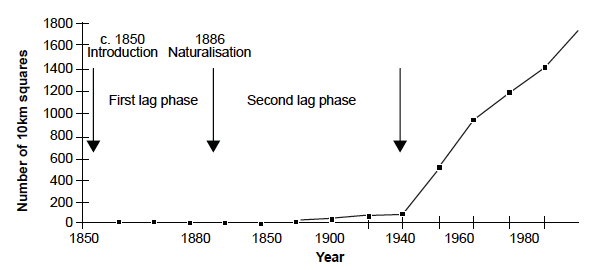
Famously the site of the 2012 Olympic park, which had been largely left unmaintained before development, cost £70 million purely on the control and removal of Japanese Knotweed and invasive non-native species like Giant Hogweed and Himalayan balsam in an area the size of 3and half football pitches. An extreme case no doubt but considering that it all originated from a SINGLE piece of rhizome of Japanese Knotweed in 1850 you can begin to understand the severity of the problem.
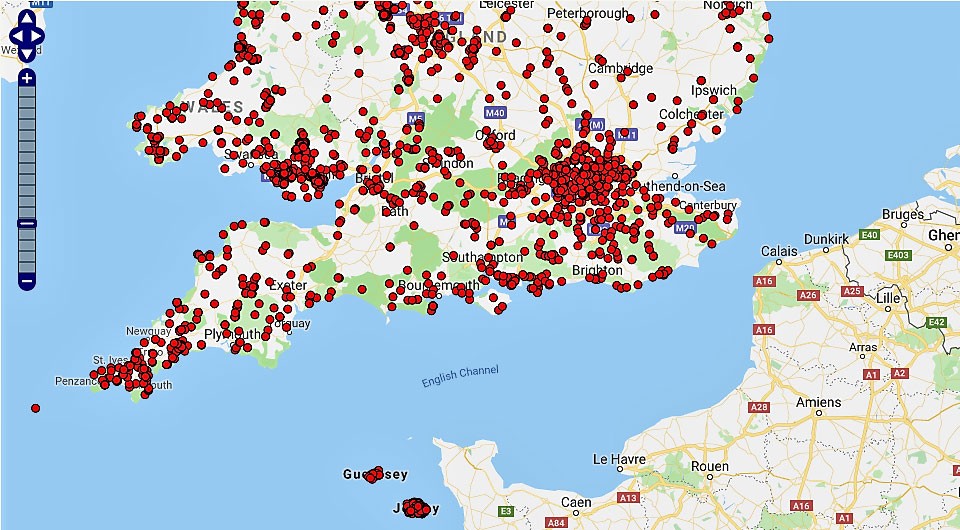
Thankfully large scale infestations are no longer a common occurrence as agencies, the government and developers consider and understand the economic and environmental impacts of Japanese knotweed and non-native invasive species.
However a knock on effect has been placed directly in the laps of the average unsuspecting public and communities. The costs have been so great for these remediation’s and eradication programs that levels of adverse risk have greatly increased with any presence of Japanese Knotweed near assets or property, causing a distinct reluctance from financial institutions to lend on mortgages and insurers to cover the risk.
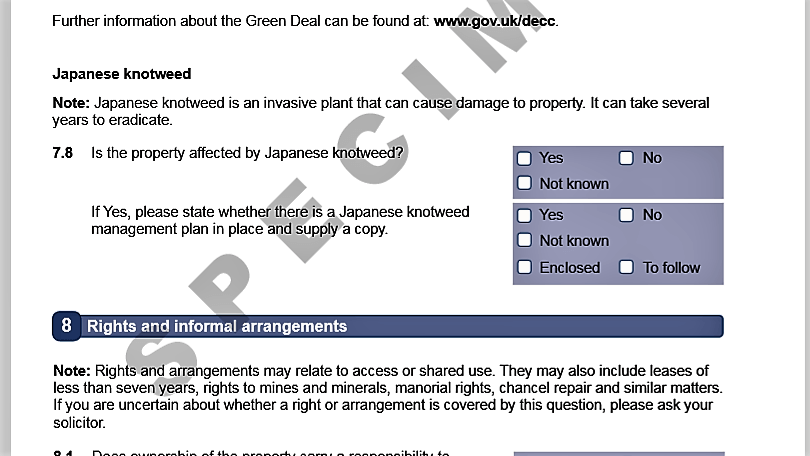

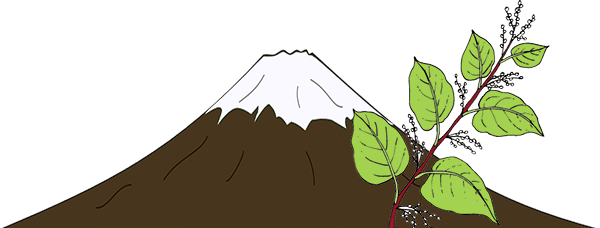
Japanese Knotweed - 1 Volcano - nil
How can we help you?
Why won’t my mortgage company lend if Japanese knotweed has been detected?
The concern from lenders, is the potential for damage to the property, drainage and hard standings caused by the unseen parts of the plant and a reluctance for building insurers to cover damage that they deem to be gradual.
There has also been a lack of understanding to the severity of the issue of the presence of Japanese knotweed. The royal institution of chartered surveyors (RICS) have gone some way in developing a scale of risk to help clarify this. Meaning that the presence of Japanese Knotweed does not automatically mean the worst.
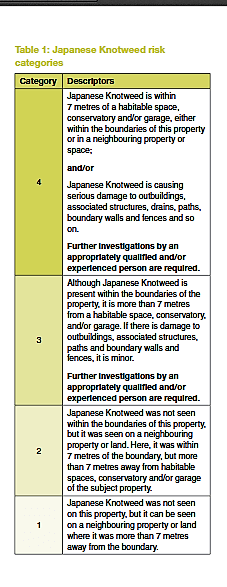
RICS Professional Information, UK – Japanese Knotweed and residential property (PDF document)
What does a Japanese Knotweed Survey consist of?
A request to survey will entail liaising onsite with a qualified surveyor. Regardless if you know exactly where the Japanese Knotweed is on the property or land, or you have difficulty identifying it, the first contact and chat with you is incredibly useful as you can provide a great deal of historical and geographical information.
A thorough walk through of the site will reveal any evidence of Japanese Knotweed, even in the winter time there are always indicators. We would also be looking for clues and information as to how Japanese Knotweed arrived at the location in the first place and how to prevent it from contaminating the rest of the property or land, this is known as biosecurity. The site will then be measured and any Japanese knotweed plotted in relation and proximity to any dwellings or hard standings. It will also be established as to any Japanese knotweed in neighbouring properties or land..The information will be presented in a survey report in which a site plan will be generated and additional research will have been obtained to clarify any evidence e.g. land registry or aerial maps.
I have looked at your website and I’m sure that I have Japanese knotweed am I breaking the law by having it on my property?
It is not illegal for you to have Japanese knotweed on your property but it is your responsibility take on the role of remediating the problem.
Ignoring the problem will effect not just your property and its localised environment, but your neighbours properties and any others natural areas such as park land, water ways and areas of social or special interest. Failure to acknowledge your responsibility could bring you to the attention of local authorities and the police who have the power to issue community protection notices.
Removing material from site that contains Japanese Knotweed must be classified as controlled waste.
It is illegal to dispose of controlled waste in the incorrect manner and without registering to do so and certainly disposing of Japanese Knotweed controlled waste improperly can result in prosecution.
I want to buy or sell a house that has Japanese Knotweed. How will the mortgage get approved?
With a better understanding of the implications of Japanese Knotweed, lenders are now far more likely to approve a mortgage for a property with Japanese Knotweed present.
Guidance from RICS, the environment agency, INNSA, The Property Care Association and a solid template for treatment by trained contractors like ourselves have combined to satisfy lenders that the Japanese knotweed will be controlled and remediated.
The first stage is to commission or seek evidence of a standard Japanese Knotweed Management Plan this will confirm a commencement date, projected completion date and consist of:
- 3 years treatment
- 2 years monitoring
- Annual end of season reports (documenting progress of treatment)
- Certificate of remediation after two years of no consecutive re- growth
Each individual case of Japanese Knotweed is unique to its setting so we will devise the best solutions and recommendations to tailor make your management plan
Combining a standard management plan with an insurance backed guarantee (IBG) is the most effective way to satisfy lenders. A 5 year guarantee in addition to a 5 year management plan gives 10 years of cover which can be insured through a specialist insurer. Insurance backing your management plan and guarantee means that from the immediate start of treatment you are covered in the event that a contractor is an unable to complete their obligation due ceasing to trade for whatever reason. The Insurer will have full details of the management plan and will be able to allocate a new contractor to complete and honor the full term.
What is entailed in the control and eradication of Japanese Knotweed?
Extensive studies have shown that the safest and most cost effective way to remediate and eradicate Japanese Knotweed and Invasive non-native plants is with herbicide treatment.
This can be via knapsack sprayer or stem injection depending on where the stands of Japanese knotweed are and how large they are. Knapsack sprayer application is perfect for areas that do not contain specimen shrubs desirable annuals, perennials, lawns and grasses in very close proximity. The delivery method is incredibly effective at getting full coverage of all above ground foliage of Japanese Knotweed.
Stem injection is also very successful and highly effective in the eradication of Japanese Knotweed and is ideal if Japanese Knotweed is growing in formal gardens, areas of special scientific interest (SSSIs), Special Protection Areas (SPAs) Special Areas of Conservation (SACs) or other ecological restraints.
Revegetation should always be a consideration once a management plan is in the completion phase .This is a crucial opportunity to reinstate biodiversity after an invasive attack and can also be an effective way to prevent other INNS from exploiting a vulnerable location.
What type of herbicides do you use? Are they harmful to humans and animals?
We use a glyphosate based herbicide which can only be obtained under licence and must pass through stringent health and safety testing.
There are no restrictions as regards to exclusion from the area for humans or animals after application. Glyphosate is a systemic, non-selective herbicide which only targets and inhibits certain enzymes in plants, vital for protein conversion, growth and cell integrity
All our operatives must have passed a specific examination in the safe use of pesticides and herbicides before handling and applying to Japanese Knotweed or any other INNS
In the event that Japanese Knotweed is close to water courses or ditches, application for consent will be made to the environment agency. Glyphosate is one of the very few herbicides that will be considered in use around water.
Glyphosate is also non residual meaning that it will dissipate on contact with soils and will not remain or contaminate. We follow closely, current legislation and would never actively use a product that put yourself, ourselves or animals at risk.
Herbicide application seems to take quite a long time: are there any other methods you can use?
Yes, there are more timely methods, they require larger expenditure best suited to larger developments:
Stockpiling and Bunding
Excavation of Japanese Knotweed rhizome infested soils after initial herbicide treatment, relocation to an unused part of the site or land, deposited in shallow membraned trench and spread to height of no more than 0.5m to allow regrowth to be treated
Burial
Excavation of Japanese Knotweed Rhizome infested soil must be encapsulated and buried to a minimum depth of 2m and covered with 5m of soil with consent granted from the environment agency
Root Barrier
- Installation to prevent or to retain Japanese Knotweed contaminated soil
- A Geotextile is installed to an optimum depth of 3m
- Which will run deeper than Japanese knotweed rhizomes thus containing the infestation
Excavation and removal off site
- A meticulous plan must be devised that designates specific haulage routes
- Prevention of spillage of contaminated soils
- Specific use of tracked vehicles
- A Japanese Knotweed Clerk of works
- Stringent bio securities
- A controlled waste declaration and consent from the environment agency
What areas of the UK do you cover?
Our invasive plants control and removal services cover the following areas: Dorset, Bournemouth and Poole. We also cover the following counties: Hampshire, Wiltshire, Somerset, Devon, Gloucestershire and Bristol & Bath.

